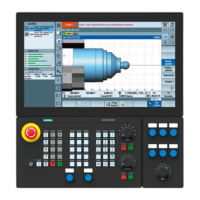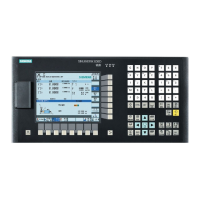Path traversing behavior
9.3 Curve tables (CTAB)
Job planning
Programming Manual, 03/2006 Edition, 6FC5398-2BP10-1BA0
9-29
Example of the use of CTABSSV and CTABSEV
Determining the curve segment belonging to master value X = 30.
N10 DEF REAL STARTPOS
N20 DEF REAL ENDPOS
N30 DEF REAL GRADIENT
...
N100 CTABDEF(Y,X,1,0) ;Begin of the table definition
N110 X0 Y0 ;Starting position 1st table segment
N120 X20 Y10 ;End position of the 1st table segment =
N130 X40 Y40 ;Start position of the
;2nd table segment ...
N140 X60 Y10
N150 X80 Y0
N160 CTABEND
...
;End of table definition
N200 STARTPOS =
CTABSSV(30.0, 1, GRADIENT)
;Start position Y in segment 2 = 10
... ;End position Y in segment 2 = 40
N210 ENDPOS =
CTABSEV(30.0, 1, GRADIENT)
;Segment 2 belongs to LV X = 30.0.
Reading table positions, CTAB, CTABINV
CTABINV therefore requires an approximate value (approxLV) for the expected leading
value. CTABINV returns the leading value that is closest to the approximate value. The
approximate value can be the leading value from the previous interpolation cycle.
):
/:
):
/:
DSSUR[
GHJUHHV
0DVWHU
YDOXH
6ODYHYDOXH
GHJUHHV
0DVWHU
YDOXH
6ODYHYDOXH

